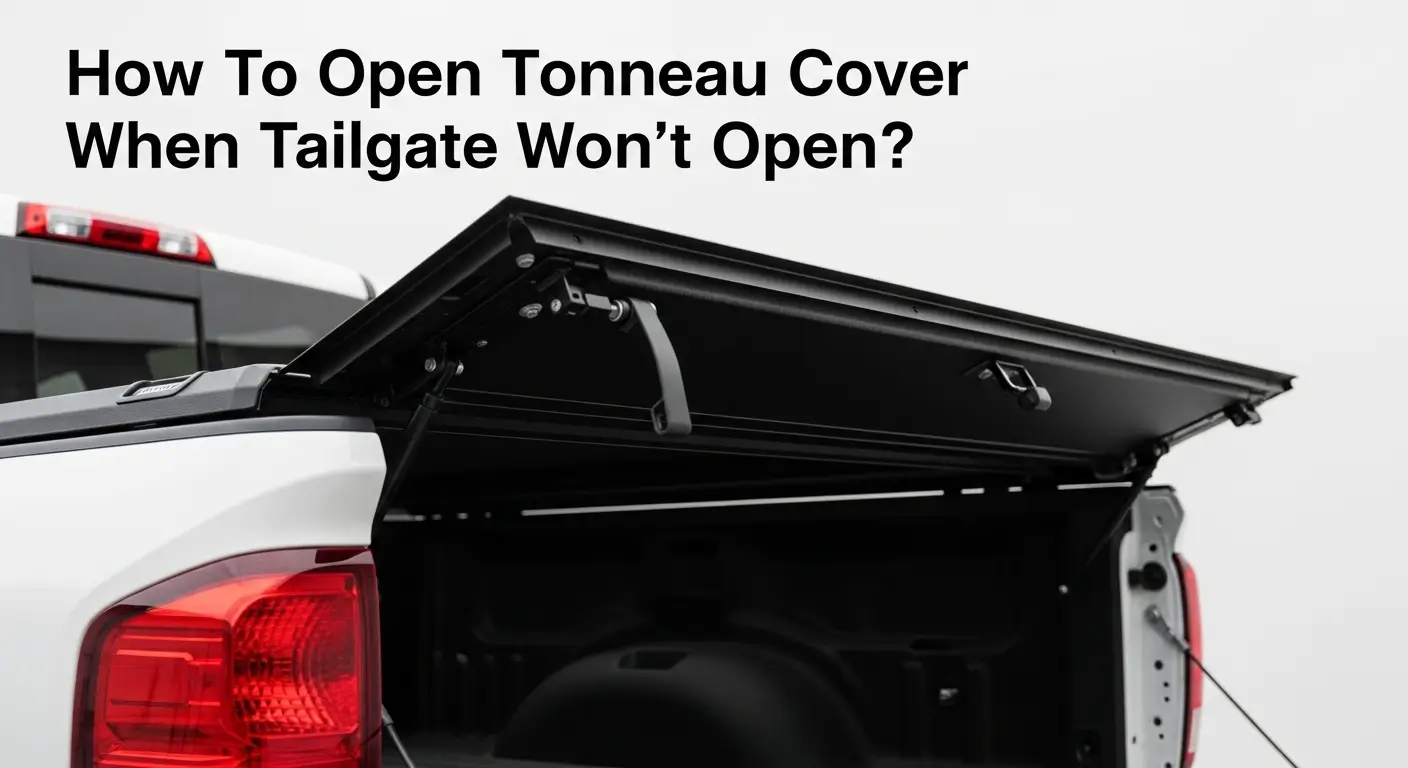Whether you have a new pickup or are upgrading your rig, figuring out “what size tonneau cover do I need” is the critical first step.
A properly fitting tonneau cover not only shields your gear from weather and theft, but also gives your truck a sleek, finished look.
But truck beds come in many lengths and widths – even two models from the same brand can vary by inches – so guessing won’t do.
In this guide, we’ll show you exactly how to determine the right tonneau cover size for any truck, with step-by-step measurement tips, examples from popular models, and insider advice on cover types and installation. By the end, you’ll know how to measure your bed like a pro and pick a cover that fits perfectly.
Table of Contents
Why Getting the Right Cover Size Matters
Picking the correct size cover is more than just a formality – it’s about protection, performance, and ease of use.
If a cover is too small, it won’t seal the bed, leaving gaps for rain, snow, and prying eyes. Too big, and you’ll struggle to latch the tailgate or fasten it at all. The right fit means:
- Full Coverage: A snug cover seals edges and keeps water, dust, and debris out of your bed.
- Ease of Use: Proper size ensures the cover opens, closes, and latches without extra force or modification.
- Security and Safety: A well-fitting hard or soft cover adds security for your cargo. Loose covers can flap in the wind or get torn.
- Fuel Efficiency: Studies show a good cover can slightly improve aerodynamics (by ~5-6% drag reduction), which may boost highway fuel economy by a couple of percent. Even small gains matter when you’re logging miles.
In short, a custom fit cover works as it should-protecting tools, groceries, camping gear, or everyday cargo-without headaches.
The right size also prevents damage: if you somehow try to force a too-small cover, it could bend the rails or stress the tailgate. Measure once, and you’ll save time, money, and frustration later.
Understanding Truck Bed Sizes
Truck beds generally come in three length categories: Short, Standard, and Long. However, these terms can be confusing because manufacturers use them differently. Here’s a breakdown of common bed lengths in feet and inches:
- Short Bed (True Short) – Typically around 5.5 feet (66-68 inches) long. Some trucks even have shorter mid-size beds near 60 inches.
- Standard Bed – Usually around 6.5 feet (78 inches). This is very common on full-size pickups with an extended or crew cab.
- Long Bed (True Long) – About 8 feet (96 inches). Often called an “8-foot bed” in spec sheets, but actual lengths can be a couple inches over.
- Intermediate “Standard Long” – Some trucks label a 7-foot bed as “long” in their lineup (especially on mid-size pickups or double cabs). True long beds (8 ft) are more common in old-school or commercial trucks.
How to Measure Your Truck Bed for a Tonneau Cover?
Taking accurate measurements is the most important step. Follow these steps carefully, and write down your numbers in inches (most cover sizes are listed in feet/inches, but you’ll want the precise figure first).
1. Prepare the Truck
2. Measure Bed Length
3. Measure Bed width
4. Double-Check
5. Consider Other Heights
6. Write It Down
Tips Before Measuring
Tailgate Position: Always measure with the tailgate in its normal closed position, as if the cover were installed. If your tailgate folds down, shut it as usual. Covers are made to wrap around a closed tailgate edge, not an open one.
Inside Rails: Measure to the inside of the rails or inner bed flanges, where cover frames sit. Do not include any rail caps or outer edges in the width.
Bed Liner: If you have a liner, measure inside it. Liners can add a fraction of an inch on each side.
Bed Rails / Accessories: Aftermarket rail systems or bed clamps may slightly reduce available width. If present, measure between the rails as they currently stand.
Odd Bed Shapes: Some beds with built-in storage (like RamBox) or unique shapes may require special covers. A full measurement is still needed, but you might need a cover made for that feature.
Common Truck Bed Lengths and Cover Sizes
Understanding a few typical examples helps put your measurements in context. Here are rough bed lengths for popular trucks (models listed with typical 2020-2025 sizes):
| Truck Model | Bed Lengths (Approx.) | Common Cover Sizes |
|---|---|---|
| Ford F-150 / F-250 (Half-Ton / Super Duty) | 5.5 ft (~66–67″), 6.5 ft (~78–79″), 8 ft (~97–98″) | 6′, 6.5′, or 8′ |
| Chevrolet Silverado / GMC Sierra 1500 | 5.8 ft (~70″), 6.6 ft (~79″), 8.2 ft (~98″) | 6′, 6.5′, or 8′ |
| Ram 1500 | 5’7″ (67″), 6’4″ (76″), 6’7″ (80″); older 3500s up to 8′ | 5.5′, 6.5′, or 7′ (some 6.8′) |
| Toyota Tundra | 5.5 ft (~66″), 6.5 ft (~78″), 8.1 ft (~96.5″) | 6′, 6.5′, or 8′ |
| Nissan Titan | 5’6″ (66″), 6’6″ (78″), 8′ (96″) | 6′, 6.5′, or 8′ |
| Toyota Tacoma (Midsize) | 5 ft (~60″), 6 ft (~73″) | 5′ or 6′ |
| Chevy Colorado / GMC Canyon | 5 ft (~62″), 6 ft (~74″) | 5′ or 6′ |
| Ford Ranger / Honda Ridgeline / Jeep Gladiator | ~5 ft (60–63″), some 6 ft options | 5′ |
| Nissan Frontier | ~6 ft (73″) in crew cab models | 6′ |
These are guidelines. Always rely on your exact tape measure numbers. Covers are often labeled in round feet (5′, 6′, 6.5′, 8′), so if your bed is, say, 79 inches (6’7″), you would get a 6.5 ft cover if available, or sometimes people use an 8 ft cover on a 6.5 ft bed by trimming or overlapped fit (not usually recommended). Ideally, your measurement will match a standard cover size or fall just under one.
Choosing Your Tonneau Cover Type and Style
Once you have the right size, consider the cover style that fits your needs. Size aside, different cover types have various advantages:
Soft Roll-Up Covers (Vinyl): These are flexible, light, and usually easiest to install. They roll up toward the cab and secure with straps or latches. Soft covers tend to have a little more give in fit, since the material can flex, but you still need the proper frame width. They’re great if you want quick full bed access by rolling the cover up.
Hard Folding Covers: Tri-fold or quad-fold hard covers are rigid panels (often aluminum). They fold back section by section. They offer strong security and weather protection. These need very accurate length and width – a hard panel won’t flex. But they allow partial bed access (fold some panels) or full access (fold all).
Retractable (Roll-Up) Hard Covers: These are hard, often aluminum or polycarbonate, and roll into a canister at the front. Some are manual crank, others are electric. They combine strength with nearly full bed access, but again sizing must be precise for the rail system.
One-Piece Fiberglass/ABS Covers: These are solid shells (sometimes called truck caps or shells) that lift as one piece or hinge. They are very secure and waterproof, but rarely remove; you almost never take them off. Measuring is crucial here because you often have little to no tolerance.
Special Covers: There are also unique designs like Tonneau surfaces with solar panels, or covers integrated with slide-out bed extenders. These will have specific sizing info from the maker.
No matter the type, once you have your L x W, look for covers listed to fit that size or your specific truck model/year.
Many brands sell covers keyed to a particular make/model (especially big-box stores) so if you enter your year/make/model, they’ll show the correct length/width fits for your truck. This can be a shortcut, but it’s still wise to verify your measurements match.
Conclusion: Measure Twice, Cover Once
Choosing the right tonneau cover size isn’t guesswork-it’s precision. By carefully measuring your truck bed’s length and width, accounting for liners or accessories, and matching those dimensions to a cover made for your truck, you ensure a perfect fit.
A properly fitting cover not only protects your cargo from weather and theft, but can also tidy up wind resistance and keep your truck looking sharp.
Remember: accurate measurement is the first and most important step. Get out the tape measure, follow the steps above, and you’ll eliminate doubts.
With the right size in hand, pick the cover style that fits your lifestyle and budget. Whether you roll up a soft vinyl cover or fold back a hard tri-fold, knowing you have the exact fit will make the investment worthwhile.
Protect your gear, enhance your truck’s look, and enjoy that peace of mind. Now that you know what size tonneau cover you need, it’s time to measure your bed, order your cover, and hit the road with confidence!






